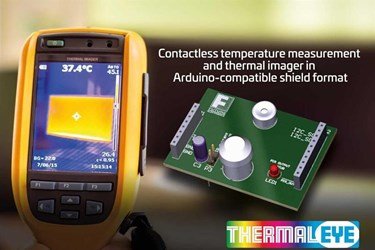Future Electronics has introduced an Arduino-compatible development board which implements
contactless temperature measurement and far-field thermal imaging at a resolution of 32×24
pixels.
The board may be used as a platform for the rapid development of various new smart system and IoT applications. Potential use cases include:
- Presence detection and detection of abnormal behaviour to enable automatic control of functions such as lighting, climate control and safety alerts. People detection through low-resolution thermal imaging protects users’ privacy.
- Remote safety monitoring of devices at risk of overheating, such as chargers, batteries, fuses, high power equipment and kitchen equipment.
- Preventive maintenance
- Remote temperature measurement of objects heated in a kitchen or in an industrial process
The development platform is based on an Arduino-compatible thermal imaging shield. This shield board features the MLX90640, an infrared sensor from Melexis which has a 32×24 array of IR photodetector pixels. The board also includes a Panasonic PaPIR pyroelectric infrared sensor.
The outputs from the thermal imaging board are provided via an I2C interface to an edge computing board featuring an i.MX RT crossover processor from NXP Semiconductors. The i_MX RT1050 or RT1060 runs driver software for the MLX90640 and PaPIR sensors as well as for a 4.3” LCD colour monitor from Tianma.
With the edge computing board, Future Electronics also supplies sample application code for thermal imaging. The readily scalable system is based on the Arm MBED operating system, which supports connectivity, security and real-time control functions. The processing capabilities of the I_MX RT1050/60 enable thermal image processing and people detection functions to be performed locally, eliminating the time lag and bandwidth consumption associated with cloud-computing architectures, while enabling operators to guarantee the protection of users’ privacy.
The MLX90640 from Melexis performs contactless temperature measurement over a range from -40°C to 300°C to an accuracy of ±1°C. It is housed in an industry-standard four-lead TO39 package.
Commenting Etienne Lanoy, Director of the Future Electronics Centres of Excellence, which designed the THERMALeye board, said: “The MLX90640 opens up new possibilities for the application of thermal imaging, because its resolution is high enough to support accurate people detection, but low enough to keep the system cost affordable.
“With the introduction of the THERMALeye platform, Future Electronics is giving design engineers a head start in application development, since it provides not only the sensor and processor boards and a ready-to-use LCD screen, but also drivers and sample application code,”
The THERMALeye board will be available to qualified customers of Future Electronics in Q1 2019.

